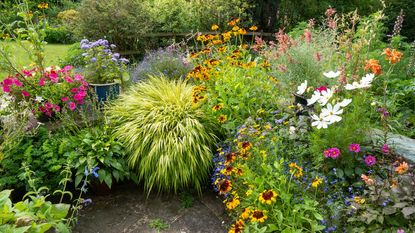Drawbacks And Benefits Of Growing Annuals


Annual plants are beautiful and can be wonderful in a garden but, unlike perennials, they demand constant attention from spring until the first frost in fall. It's important to understand the growth habits of both, including annual flower pros and cons, before you go shopping for seeds or plants. While there are benefits of growing annuals, there are downsides too. Read on for all the information you need to figure out whether annuals are right for your garden.
Annual Flower Pros - Reasons to Plant Annuals
(Teo's viewpoint) If you aren't sure about the differences between annuals and perennials, here's an easy way to remember it. An annual event takes place once a year, like Christmas or your birthday. Annual plants "take place" once a year as well. That is, annuals germinate, grow, bloom, seed and die in one growing season. Perennials live at least two years or more. While that may seem to give perennials a big advantage, there are lots of benefits to growing annuals too. Below are just some reasons to plant annuals. Annual flowers grow quicker and bloom longer. Annuals have a lot of work to do in one season, so they are efficient plants, germinating and growing quickly. And they often stay in flower all season long. Perennials have more time but start slower, often blooming for just a few weeks, then putting energy into preparing for the next season. Annuals come in a multitude of colors. Another of the benefits to growing annuals also stems from their short lives. Annual blooms are usually bright and vivid. They need to attract pollinators and they don't have time to waste. You can count on filling up empty beds quickly and dramatically with annuals, mixing colors and heights to create the palate you want. Annual plants are not expensive. Annuals cost less than perennials, whether you buy them as seeds or seedlings. That makes sense when you consider that perennial roots live for two or more seasons. But it also means that for a lot less money, you can fill your garden with bright annual blooms. And change your color design year after year. Many types of annual also self-seed. You may have to sow seeds every year for annuals, but you may not. Many species of annuals reseed themselves, saving you the trouble. Annuals are so easy to grow. You plant, water and sit back and enjoy the show. With perennials, you have to worry about giving the plants the maintenance they require to continue to grow year after year.
Cons of Annual Flowers - Reasons Against Planting Annuals
(Mary's viewpoint) Although they continue to be wildly popular, there are many disadvantages of annuals in the garden. Annuals may not be the best choice for gardeners who are unable to dedicate the tremendous amount of time required to keep these colorful but short-lived plants looking their best. Consider the following reasons against planting annuals: Cost can add up year after year. Annuals, which tend to be relatively inexpensive, last only for a single year. So, in the long run, they are substantially more expensive than perennials, which live at least three or four years and usually much longer. Most annual plants cannot take cold. Annuals are sensitive plants that can't handle much cold. As a result, they can't be planted until you're certain the last frost of the season has passed. This means a short blooming season for chilly northern climates with short growing seasons. They tend to require more frequent watering. Watering is tricky and some annuals, especially those in hanging pots, must be watered daily (sometimes twice during hot, dry weather). However, while most prefer rather moist conditions, they tend to rot easily if they are overwatered. Insects attack them more. Annuals are more pone prone to slugs, aphids, and a variety of other harmful pests. They require more maintenance for continual blooms. If you want to keep annuals blooming, most varieties must be deadheaded frequently - often daily. Otherwise, the plants will go to seed and blooming will rapidly decline. This is a time-consuming task if you plant a lot of annuals. Also, regular fertilization is required to keep annuals in full bloom. Additionally, some annuals get spindly and unsightly in midsummer. Pruning and trimming are necessary to keep them looking good for a few more weeks.
How to Overcome the Disadvantages of Planting Annuals
If you're a busy person without a lot of time to spend in the garden, perennials make more sense since they tend to care for themselves. That's not to say that you cannot still enjoy having annuals in the garden. If you like the pop of color that annuals provide, plant a few in strategic locations. Also, look for annuals that are self-cleaning, such as calibrachoa or wave petunias, as well as those that are more tolerant of drought so you won't have to water as often.
Gardening tips, videos, info and more delivered right to your inbox!
Sign up for the Gardening Know How newsletter today and receive a free download of our most popular eBook "How to Grow Delicious Tomatoes."

A Credentialed Garden Writer, Mary H. Dyer was with Gardening Know How in the very beginning, publishing articles as early as 2007.
-
 10 Best Apartment Plants To Turn Your Small Space Into An Oasis
10 Best Apartment Plants To Turn Your Small Space Into An OasisThe best apartment plants can lend an ambience of the tropics, brighten up a space, or add a touch of drama, and turn an apartment into a relaxing oasis.
By Amy Grant
-
 Grow a Bathroom Oasis: 8 Best Bathroom Plants With No Light or Low Light
Grow a Bathroom Oasis: 8 Best Bathroom Plants With No Light or Low LightSome apartment dwellers grow the best bathroom plants with no light or low light. Read how one of our favorite plant lovers does it in the big city.
By Teo Spengler